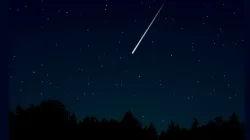Draconid Meteor Shower 2024: Catch dozens of shooting stars this October
The Draconid Meteor Shower 2024 is expected to peak on October 8, with around 10 meteors per hour. The best viewing time is suggested after sunset, as the moon will set a few hours later, minimizing light interference and allowing for clearer views of the meteor shower.

The Draconid Meteor Shower is set to dazzle stargazers on October 8 and 9 this year. Known for its association with the constellation Draco, this annual celestial event offers a rare chance to see meteors during the early evening hours. Unlike most meteor showers, which are best viewed in the pre-dawn hours, the Draconids can be enjoyed right after sunset, making it perfect for casual skywatchers.
When and where to watch the Draconids
Visible in the Northern Hemisphere on October 8 and 9
The Draconid Meteor Shower will be best observed from the northern hemisphere, where Draco, the dragon-shaped constellation could be found in the night sky. On October 8 and 9, the meteors will appear to radiate from the “tail” of Draco, positioned above the Big Dipper in the north-northwest sky.
This meteor shower occurs as Earth passes through the debris trail left by Comet 21P/Giacobini-Zinner, a comet that crosses Earth's orbit every 6.5 years.
How many meteors to expect?
Around 10 meteors per hour with favourable viewing conditions
The Draconids are known for their unpredictability, and this year the American Meteor Society estimates around 10 meteors per hour during the peak. The best time to observe this spectacle will be right after sunset on October 8, with minimal interference from moonlight, as the moon will set a few hours after dusk.
Why the Draconids are special
Evening visibility makes for a unique stargazing experience
Named after Comet 21P/Giacobini-Zinner, the Draconids may not have the highest meteor count compared to other showers, but their visibility during evening hours sets them apart. This year, with favourable conditions and less moonlight, it’s a great chance to enjoy shooting stars without needing to stay up late. If you're hoping for a serene, early night under the stars, the Draconid Meteor Shower 2024 is the event to watch.
ALSO READ: SpaceX Falcon 9 faces setback: FAA grounds rocket over second-stage malfunction
The malfunction caused the Falcon 9 booster to fall into an area of the Pacific Ocean outside the designated safety zone approved by the FAA for the mission.
ALSO READ: NASA's Hubble telescope reveals stunning Spiral Galaxy in deep space
The resulting mission is said to become the first in a new class of NASA astrophysics missions within the agency’s longstanding Explorers Program. The new mission class, Probe Explorers, will further fill a gap between flagship and smaller-scale missions in NASA’s exploration.